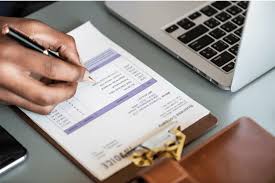Invoices are a vital part of any business. They’re used to track sales, record payments, and manage inventory. But what exactly is an invoice? And what information does it need to include?
In this article, we’ll answer all of your questions about invoices. So whether you’re a business owner who’s new to invoices or you’re just looking for a refresher, read on for everything you need to know.
What Exactly is an Invoice
An Invoice is a time-stamped commercial document that lists the specifics of a transaction between a buyer and a seller and records it. The invoice often details the conditions of the contract and lists the acceptable forms of payment if goods or services were acquired on credit.
The Fundamentals of an Invoice
An invoice must clearly identify itself as such on the front of the document. It often has an invoice number, a distinctive identity that can be used for both internal and external references. Invoices often include the seller’s or service provider’s contact information in case there is a billing problem.
On the invoice, payment terms may be listed together with any applicable discounts, early payment information, or finance costs for late payments. It also displays the cost of each unit, the total number of units purchased, the freight, handling, and shipping costs, as well as any applicable taxes, and it lists the total amount owed.
The Value of the Invoice Date
The invoice date indicates the time and date that the items were billed, and the transaction was formally documented. Since the invoice date determines the credit period and bill due date, it contains important information about payments. This is especially important for businesses that extend credit. The invoice’s actual due date is typically 30 days following the invoice date. Similarly to this, businesses that provide customers the choice to return things usually have a deadline based on a specific number of days following proof of purchase, as stated on the invoice.
E-Invoicing
People and businesses have found it simpler to rely on electronic invoicing as an alternative to paper papers since the dawn of the computer era. Electronic invoicing, often known as e-invoicing, is a type of electronic billing used to create, store, and track records connected to transactions between parties and guarantee that the conditions of their contracts are met.
What does an Invoice Serve as
Invoices are more than just a formal record that contains the details needed to request payments from clients. They can assist you in maintaining organization and a professional appearance when submitting your taxes. Here are the main justifications for why invoices are necessary:
#1. Facilitates Precise Bookkeeping
To assist in tracking sales, invoices keep track of incoming money. They record when a product was sold or when a project was finished, together with the amount of money earned. This information is necessary for keeping precise accounting records and for adding together revenues and expenses to determine important metrics like net profit, net margin, and asset turnover ratio.
#2. Offers a Legal Defense
What would you do in the event that a client erroneously claimed you failed to deliver the products as promised? Or what if a client declined to pay you for the services you provided?
You’re saved by a professional invoice that functions as a legal document. Correct invoices can shield your company from frivolous claims. Customers typically pay unsigned bills without any problems.
However, invoices must have a signature to be considered official if you want them to be considered legal papers. Proof that both parties understood the business rules and agreed to abide by them is a signed invoice with all the necessary information. It serves as a trustworthy record of the transaction that proves the seller’s entitlement to compensation.
#3. Simplifies Tax Preparation
Invoices support the information you include on your tax forms and act as a trustworthy data source for audits. When you document and keep all of your invoices, filing taxes becomes a hassle-free process in any country. For instance,
The Internal Revenue Service (IRS) of the United States advises businesses to keep the documentation necessary to support the income, credits, and deductions listed on income tax returns for at least seven years following the filing date of the returns. The IRS has the right to audit the returns and ask to see any supporting paperwork. Accurate tax reporting and audit readiness are easy if your company keeps an organized record of its sales invoices.
#4. Help with Business Analysis
Because invoices serve as a record of the sales you’ve made, they include important details like the unit prices of your products or services, the total sum and the dates on which the transactions occurred, etc. These records give you information on consumer purchasing trends, payment habits, and peak buying periods.
Bestsellers, time eras, and much more. Predicting demand and creating efficient marketing tactics helps you adjust your inventory so that the right customers are served the right products at the right time.
Types of Invoices
Here are a few typical forms of invoices:
#1. A Sample Invoice
It is an invoice sent by the seller to the buyer before he offers any products or services. It includes facts on the product or service’s expected cost, the scheduled delivery date, and other information about the delivered goods. After the buyer has reviewed the proforma invoice and given their approval, the seller will get to work on product delivery.
#2. Sales Invoice
The seller provides the buyer with a sales invoice in order to collect payment for the goods and services the buyer has purchased. It contains information on the vendor, the buyer’s address, the product’s delivery date, the terms of payment, the items and their pricing, and the total amount due. Additionally, it includes payment details such as bank account information that will make payments easier for the buyer.
#3. Unpaid Invoice
The buyer is typically sent an invoice, which also specifies the payment deadline. When the buyer receives an invoice for the items he has purchased and fails to pay the invoice within the allotted period. In that situation, the invoice becomes past due.
#4. Paid in Full Invoice
A combined invoice is sent by the vendor whenever a consumer conducts multiple transactions with them. He gathers all the bills for that specific client and combines them into a single document with the entire amount. Since he won’t have to pay for each invoice separately, this will save the buyer a ton of time.
#5. Cash-Out Memo
A credit memo is issued to the buyer in those circumstances where the seller owes them money. It is a letter written to the buyer acknowledging the sum of money the seller owes him. The buyer may use this kind of credit for further transactions.
Invoice Vs. Receipt
A bill is a statement from the seller outlining the sum due for the products or services bought from them. In a B2C scenario, such as a restaurant or retail outlet, the customer is expected to pay the bill right away. In contrast, bills payable are used in business-to-business transactions to reflect the amount that consumers owe for products and services that were purchased on credit and are due by a specific date. It may consist of utility bills, phone bills, and service invoices. Bills are used as legal proof of the transaction, just like invoices.
What Distinguishes Receipt from Invoices
Both the terms “receipt” and “invoice” refer to the same document that details the debt incurred during a business transaction. Whether you are a buyer or a seller, it makes a difference in how it is viewed.
#1. Depending on the Viewpoint
The buyer will receive an invoice from the vendor that requests payment as a bill. For instance, a freelance designer might give their client an invoice after completing their job in accordance with the contract. The received document would serve as the customer’s bill. In conclusion, sending an invoice means asking for money, and receiving a bill means paying for the item(s) purchased.
#2. Considering the Terms of Payment
In addition to this, the client’s estimated payment deadline also makes a difference. Few companies and vendors, particularly in the B2B environment, provide goods or services on credit, allowing customers to buy them and pay the vendor later in accordance with the specified payment conditions. In such circumstances, the supplier issues an invoice following the delivery of the products or services.
Major Distinction Between an Invoice and a Receipt
Receipts and invoices both serve as records of sales and generally contain the same data. When they are granted and how they are used for accounting purposes make a difference. A receipt is sent after receiving payment from the customer, not before raising an invoice to request payment from the client.
What is an Invoice Used for
An invoice is a statement that enables your company to be compensated for the products and services it renders. An invoice specifically contains the title of the item a buyer purchases, along with its price and payment terms. The maximum amount of time a buyer has to send the money they owe is typically referred to as a payment term. For instance, if the products and services are bought on credit, the invoicing payment terms specify how far in the future that credit is valid.
What Is the Purpose of an Invoice
An invoice’s most fundamental purpose is to serve as proof of purchase. Invoicing also serves other objectives and offers other advantages, such as:
- To track inventories: Businesses may keep track of both their current and future needs for inventory using sale invoices.
- Bookkeeping: Invoices record who, when, and how much a good or service was sold to. This facilitates payment tracking for both buyers and sellers.
- Legal justification: Invoices are used as official documentation of the specifics of a contract between two parties. They defend the company from any prospective erroneous litigation.
- Tax returns: Keeping accurate records of your invoices aids in the business’s ability to record revenue and accurately calculate taxes.
- Analytics in business: You can discover the most popular goods and services, the busiest shopping seasons, typical client purchasing patterns, and much more by studying invoices. Over time, this assists you in creating profitable marketing plans for your company.
Invoice Note
The previous name for this setting was: a note on the invoice’s bottom.
Purpose
By using this feature, you can include a note at the bottom of your invoice. This might be a simple thank-you note to your clients, or it could include payment preferences or company information. The information you provide in the invoice notes to your clients may be necessary for them to view or pay their invoices. You can add said notes using this setting. You can include an estimate at the bottom of the invoices you send to clients by using estimate notes. Notes on estimates typically include information on how to pay, payment conditions, etc.
- Click the profile button, select Settings, and then click Invoice Note. You may also use the search bar or the ‘Categories’ area on the left to find it.
- Fill out the field with your note as necessary, then click save.
Does Invoice Mean Payment?
An invoice is a demand for payment that the seller sends (either physically or electronically) after the sale of goods or services but before the payment has been made. Fundamentally, invoices are meant to make sure that your company is paid.
Is the Invoice a Receipt?
A receipt is sent after receiving payment from the customer, not before. An invoice is used to request payment from the client. A receipt is typically only given to customers who have made complete payments.
What is an Invoice with an Example?
A paper receipt from a store or an online record from an e-tailer are examples of documents that retain a record of a transaction between a buyer and a seller. A vital component of accounting internal controls and audits is invoiced.
Does an Invoice Mean you Owe Money?
Information regarding how much money a customer owes is included in an invoice. The company that gave the customer their goods or services considers this paper to be an invoice. After receiving this invoice, the client records it as a bill that must be paid.
How do I Make My Own Invoice?
- Brand your invoice
- Include a polished header
- Provide details about the invoice
- Include the date
- Describe the items or services that were delivered.
- Include tax information and emphasize the overall amount payable.
- Include the terms of payment.
- Include explanations and terms and conditions in the notes.
Who Needs an Invoice?
To make sure their clients pay them, businesses must produce invoices. Due to the fact that they detail the services provided and the money owed, invoices act as legally binding contracts between a company and its customers. Additionally, invoices support financial management and sales tracking for firms.
Conclusion
No matter how excellent your product or service is, you will struggle to keep clients if your post-project management is hurried and careless. On the other hand, you will be able to be paid more quickly, handle your accounts more skillfully, and expand your business more efficiently once you gain a grasp of the invoicing procedure.
Related Articles
- ACCOUNTING INVOICE: Definition, How to Record It, and Free Softwares
- FREE ONLINE RECEIPT GENERATOR; How to Create a Receipt Online for Free
- FAKE RECEIPT: Definition, How to Recognise It and Make It
- 2023 Top Free Small Business Accounting Software (Updated)
- PAYMENT TERMS: How To Use The Best Payment Terms
References






